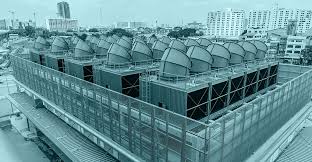Introduction
Evaporative Cooling towers are essential components in industrial and commercial cooling systems, designed to efficiently dissipate heat by utilizing the natural process of water evaporation. These towers operate by exposing warm water to ambient air, allowing a portion of the water to evaporate, which removes heat and cools the remaining water. Commonly used in HVAC systems, power plants, and manufacturing industries, evaporative cooling towers provide a sustainable and energy-efficient solution for managing thermal loads. Their ability to reduce energy consumption and reliance on mechanical cooling systems makes them a preferred choice for environmentally conscious operations.
Energy Efficiency on Evaporative Cooling Towers
- How it Works: Evaporative cooling uses the principle of water evaporation to cool air. Hot, dry air passes over water-saturated pads, where it absorbs moisture and cools down.
- Energy Savings: Unlike traditional air conditioning systems that rely on refrigerants and compressors, evaporative coolers only need a fan and water pump, resulting in significantly lower energy consumption. This makes them ideal for reducing the energy footprint of buildings.
Reduction in Carbon Emissions
- Lower Environmental Impact: Since evaporative cooling uses less electricity, it indirectly reduces carbon emissions associated with power generation, especially in regions reliant on fossil fuels.
- Compliance with Green Certifications: Many green building standards, like LEED (Leadership in Energy and Environmental Design), award points for reducing greenhouse gas emissions. Evaporative cooling aligns perfectly with these goals.
Use of Renewable Resources
- Water as a Cooling Medium: Evaporative cooling primarily depends on water, a renewable and non-polluting resource, instead of synthetic refrigerants that can harm the environment.
- Environmental Compatibility: Responsible water management in these systems ensures sustainability without depleting local water supplies.
Cost-Effectiveness on Evaporative Cooling Towers
- Initial Costs: Evaporative coolers are simpler in design and cheaper to install compared to mechanical air conditioning systems.
- Operational Savings: They consume minimal electricity and require less maintenance, reducing long-term operational costs. This makes them an economically viable solution for buildings seeking sustainable cooling.
Improved Indoor Air Quality
- Air Filtration: As air passes through the water-soaked pads, it is filtered of dust, pollen, and other airborne particles, improving air quality.
- Fresh and Cool Airflow: Evaporative cooling continuously introduces fresh, cooled air into the building, unlike traditional HVAC systems that recirculate indoor air. This reduces the buildup of indoor pollutants and creates a healthier living or working environment.
Water-Wise Design on Evaporative Cooling Towers
- Efficient Water Use: Modern evaporative cooling systems are equipped with water-saving features like recirculation and monitoring systems to minimize wastage.
- Sustainable Alternatives: When paired with rainwater harvesting systems, they can utilize collected rainwater for cooling purposes, enhancing water efficiency.
Integration with Green Building Systems
- Synergy with Solar Panels: These cooling systems can be powered by solar energy, making the cooling process entirely renewable.
- Compatibility with Other Systems: They can work alongside energy-efficient ventilation, rainwater harvesting, and passive design features to create a cohesive sustainable building system.
Application in Passive Cooling Strategies
- Complementing Passive Design: Evaporative cooling works well with natural cooling techniques like cross-ventilation and shading. By reducing the building’s heat load, the evaporative cooler’s efficiency improves further.
- Energy-Free Cooling: In well-designed passive systems, the evaporative cooling unit may run at lower capacities, saving additional energy.
Versatility in Building Types
- Residential Buildings: In homes, evaporative coolers provide an economical way to cool spaces, particularly in dry climates.
- Commercial and Industrial Applications: Large-scale units can be used in warehouses, factories, and office spaces, ensuring comfort while maintaining cost-effectiveness.
- Scalability: The systems can be customized for different building sizes and cooling needs, making them adaptable for diverse applications.
Contribution to Resilience
- Low Maintenance: These systems have fewer moving parts and no refrigerants, making them easy to maintain.
- Reliable Cooling: In regions with unreliable electricity or high cooling demands, evaporative cooling provides a dependable solution due to its simplicity and efficiency.
- Climate Adaptation: Evaporative cooling is especially effective in hot and dry regions, addressing local climatic challenges while promoting sustainable cooling practices.
Conclusion for Evaporative Cooling Towers
Evaporative cooling towers play a vital role in efficient thermal management across various industries, offering a cost-effective and eco-friendly alternative to traditional cooling systems. By leveraging the principles of water evaporation and natural heat exchange, these towers help minimize energy use and reduce environmental impact. As industries increasingly adopt sustainable practices, evaporative cooling towers remain a cornerstone in achieving energy efficiency and environmental responsibility in cooling applications.

